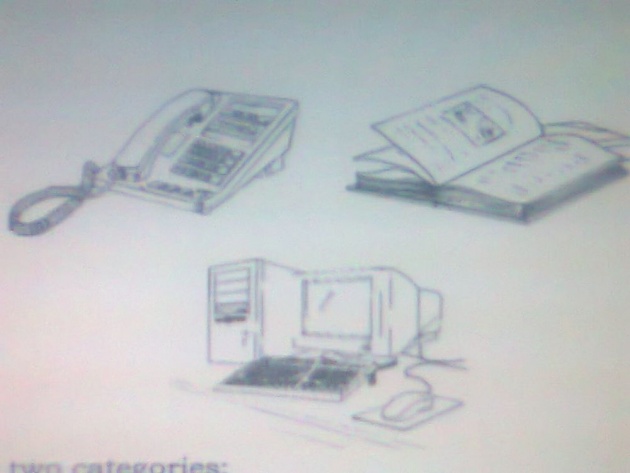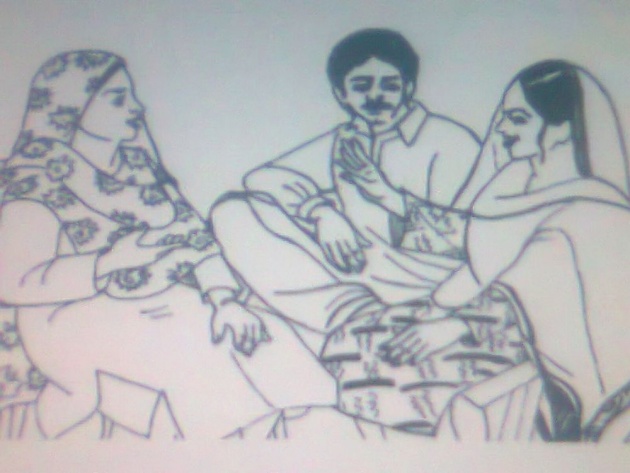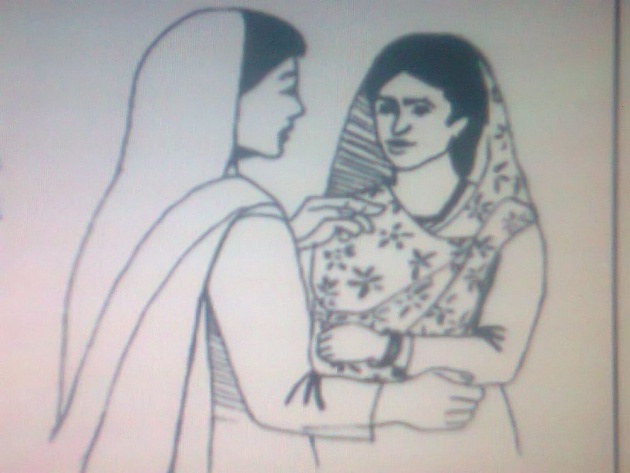INTRODUCTION:
We are continuously communicating with others throughout our life. We communicate by talking, writing and acting etc. We even communicate by touch, smile, frown or gesture. We communicate through silence too.
Even though we are experts in communication but sometimes we fail to communicate our ideas effectively and successfully. This session would help people to understand the meaning of communication, different ways to communication, obstacles to effective communication and skills of effective communication.
DEFINITION OF COMMUNICATION:
“The process of transferring information/ideas from one person to another is called communication.”
OR
“Communication is the process of generation, transmission or reception of messages to oneself or another, usually via mutually understood set of sign.”
It is also understand as the exchanging of understanding. Use of this process is developmental and transfers to all areas of life: home, school, community, work and beyond.
ELEMENT OF COMMUNICATION :
There are four element involved in Communication process:
- Sender
- Message
- Medium
- Receiver

There is a message sent by sender to a receiver with use of a medium in which message is understood by both sender and receiver.
NEED TO COMMUNICATE :
People communicate with others as:
- To give and take information
- To express feelings
- To create awareness
- To discuss ideas
- To solve problems
- To develop public opinion
- To discuss things
- For understanding
- For entertainment
It is important to remember that both persons gain in a communication.
METHODS OF COMMUNICATION
There are four methods of communication:
- Verbal (language)
- Non verbal (body language, emotion)
- Pictorial (image)
- Written (alphabet)
CHANNELS OF COMMUNICATION:



Through:
- Words/language
- Body language
- T.V/Film
- Video
- Radio
- Telephone
- News papers
- Books , magazine
- Leaflets
- Posters
- Wall chalking
- Banner
- Puppetry
- Street dramas
- Computer
- Fax machine
These cannels could be divided in two categories:
- Direct channels
These channels come under the direct control of the sender and could be easily recognized by the receiver. In this category are the verbal and non verbal channels of communication. Verbal communication channels are that use words in some manner such as spoken communication. Non verbal communication channels are those that don’t require words, such as facial and body movements.
- Indirect channels
These channels are not under the direct control of the sender.
On the basis of communication channels/ modes, communication is divided into two types.
- Direct communication
- Indirect communication
DIRECT COMMUNICATION
In this type of communication, the sender could send the message directly to the receiver without using any other channel. It is also known as interpersonal communication.
INDIRECT COMMUNICATION
In this type of communication the sender uses some indirect channel such as T.V / radio or computer to send message to the receiver.
Both types of communication have their positive and negative aspects.
DIFFERENT TYPES OF COMMUNICATION:
There are two types of Communication:
- One way Communication
- Two way Communication / interpersonal communication
ONE WAY COMMUNICATION:

In this type of communication, only one person talks and other only listens. The receiver does not allow asking questions. This type of situation is commonly seen in the life e.g. during the lecture, in a class room and in a T.V program.
TWO WAY COMMUNICATION/ INTERPERSONAL COMMUNICATION :

This type is also known as interpersonal or two way communication. In this kind of communication sender and receiver both contribute to the communication process. In this communication, they both send and receive messages. It is a better way to understand ideas and views as people could ask questions for clarification.
“Interpersonal communication is one to one communication.”
Non verbal communication is an important part of it. But two-way communication takes more time and effort than one way communication. It’s a better way to communication because:
- It is very effective way to convey message.
- It helps both persons to talk and listen to each other.
- It helps to make sure both persons understand each other.
- Can ask questions to clarify what other means.
- It creates condition of equality between both participants of the communication.
- Does not get bored, as might happen in a long lecture.
NON VERBAL COMMUNICATION:
Non verbal aspects of communication are as important as verbal. Non verbal communication is focused on face to face interaction.
“Nonverbal communication is the process of communicating through sending and receiving wordless messages.”
Such messages can be communicated through gesture, body language/ posture, facial expression, eye contact, voice quality, voice tone, emotion and speaking style.
People communicate to another through our words (verbal) and also through their gestures, facial expressions and tone of their voice.
The way of standing, sitting, looking at or looking away are all methods of non verbal communication.
What is said is as important as how it is said. A person might have come across situations where someone asks him/her ‘How are you?’ in a tone that convinces him/her that the person is not interested in knowing about the other person.
One has to ensure that his/her non verbal communication matches his/ her verbal communication. If a community worker tells a village woman that she is intelligent then through her expression she should not be conveying that the woman is really dumb.
In communicating with others, it is useful to be sensitive to their non verbal expressions in order to understand that one is being understand by them or not.
INTERACTION OF VERBAL AND NON VERBAL COMMUNICATION
When communicating, non verbal messages can interact with verbal messages in six ways:
- Repeating
“Repeating” consists of using gestures to strengthen a verbal message, such as pointing to the object of discussion.
- Conflicting
Verbal and non verbal messages within the same interaction can sometimes send opposing or conflicting messages. A person verbally expressing truth while simultaneously avoiding eye contact may convey mixed message to the receiver in the interaction. When mixed messages occur, nonverbal communication becomes the primary tool people use to attain additional information to clarify the situation.
- Complementing
Accurate interpretation of messages is made easier when nonverbal and verbal communication complementing each other.
- Substituting
Nonverbal behavior is sometimes used as the sole channel for communication of a message. People learn to identify facial expressions, body movements and body positioning corresponding with certain feelings and intentions. Nonverbal signals can be used without verbal communication to convey massages.
- Regulating
Nonverbal behavior also regulates our conversations. For example, touching someone’s arm can signal that you want to talk next or interrupt.
- Accenting/ Moderating
Nonverbal signals are used to accent or amplify the message. Nonverbal behavior can also be used to moderate or tone down aspects of verbal messages as well. For example, a person who is verbally expressing anger may accent the verbal message by shaking a fist.
BARRIERS TO EFFECTIVE COMMUNICATION:
Sometimes people are unable to communicate effectively with another person. Some things act as obstacles to successful communication.
- Attitude and values
People filter and screen what they say and hear through their values and attitudes. Thus they talk and listen to each other selectively. Sometimes these valves and attitudes act as hurdles in the process of communication.
- Beliefs People’s beliefs also affect what they communicate to other people. If a person believes that another person is intelligent then this would affect what he / she communicate to and how he/ she communicate with another person. Similarly when the other person tells the 1st person something, the 1st person would hear in a way that confirms his/her belief that the other person is intelligent.
- Communication is also affected by the moods of people involved in it. If a person has received a bad news, it is natural that if someone gives him or her information about a community meeting then he/ she would not able to understand the message.
- Pressures of work, the atmosphere in the family, what happened recently, one’s own physical well being affect people and consequently communication.
- Because people are different, they have different concepts. People need to understand these differences to communicate with each other. If they fail to understand the concepts, they would not able to communicate successfully with others.
- People have different meanings for same word or expression. It could be a barrier in communication if one may not be sensitive to this. For example in a certain community the word “bekar” is used for thief, bad and quarrelsome etc.
- Language could be another obstacle to effective communication. Apart from Urdu there are so many local languages. While communicating with a community one should use local language. Otherwise people would not understand what is being said to them. People are used to a certain terms and jargons themselves. Common people may not understand that. If someone says BHU or RHC, common person would not understand that. There are so many words and phrases people use out of habit which other people may not understand at all.
- Too long message is also an obstacle in communication as people may get bored and stop listening.
- Too much technical, complicated or to simple information is a hindrance in the process of communication.
- Ejecting an idea or opinion immediately as unrealistic may destroy communication. If that happens, the person who gave opinion may shut up and not speak later.
- Different people perceive things differently. Sometime we are right but afraid of giving arguments. People should acknowledge other people right to see things differently.
- Give arguments but avoid proving others wrong or directly criticizing them. As it would discourage them to participate in communicate any more.
- Listening with preconceived ideas stop communication.
- Culture, class, education, gender, experience, age and religion etc. affect communication.
- Ambiguous message creates misunderstanding and may affect communication.
- Laugh at or dismiss is destructive in communication.
- Non verbal communication conflicting with verbal communication may create confusion and affect communication.
AIDS TO EFFECTIVE COMMUNICATION:
Communication could become more effective by adopting following features:
- Communication should take place in comfortable environment
- Treat people with respect.
- Use local, simple and easy to understand language.
- Use suitable and effective communication method considering the community.
- Information should be delivered in a certain pattern.
- Message should be comprehensive and concise.
- Choose correct and effective words according to local traditions.
- Message should be according to receiver’s metal, awareness and educational level.
- Message should not be too complicated or too simple.
- Respect other people’ opinion.
- Listen to them and pay attention to them.
- Take feed back.
- Be Patient. Patience helps in effective communication. In order to understand, the listener may ask several questions. The speaker should be patient with him/ her. If ask him/her opinion, he/she may not know how to answer quickly and directly.
- Some people are shy to speak while others speak freely. If communicating in a group, encourage everyone to speak.
- Don’t give answer for other people. Encourage them to give answers and express their opinions.
- Be Tolerant. When someone begins to talk, he/ she may fumble, utter incomplete sentences, make mistake. Be tolerant and don’t interrupt.
- Repetition. Saying the same thing in two or three different ways helps in communication an idea. Repetition also helps in understanding.
- Be sensitive to their non verbal expressions in order to understand that one is being understood by them or not.
- Give correct facts. Don’t add any information without confirming.
- Instead of giving wrong information, just tell that you would check with experts.
- Give solid facts and correct figures.
- Avoid irrelevant information.
- Message should be clear.
- Avoid using double meaning words.
- Sometime people talk down to others. They think that they know more than others. On the other hand, sometimes in their enthusiasm to create confidence in the listeners, people talk up to them and pretend as others know all. Neither talking “up” nor “down” to another person is helpful in communication. When people talk to each other as equal effective communication take place.
- Take interest in their lives and share their actives.
- Sympathize with people when they are sad or crying.
- Interpersonal Trust. When the listeners trust the speaker, they would listen to the speaker. They would also talk to him/ her openly and freely. Establishing interpersonal trust is critical for effective communication.
- Being genuine, honest, sincere, interested in people well being and open about oneself helps to win people trust and promote effective communication.
- Sometime it’s difficult to communicate a new concept to the people. Use of a proverb or an example related to their lives could make the point comprehensible.
- Humor has important place in effective communication. Telling a joke makes the atmosphere light, reduces tension and creates a friendly feeling. Use humor effectively in communication.
- Non verbal communication should match verbal communication. It is most important for successful communication.
- The speaker could communicate effectively through his/her actions. If the speaker wants other people to share their feelings, he/she could set example by doing the same.
LISTENING SKILLS :

We were given two ears and one mouth. This is because God knew that listening was twice as hard as talking.
It is also said that
“Listening is as powerful a means of communication and influence as to talk well.”
A very important element in effective communication is to listen to what the other is saying. Through listening one could also know what others are thinking about him/ her.
One’s presence may affect them. Thus one must learn to listen as well as to speak. Those who dismiss this are already demonstrating an indisposition to listening. If a person does not develop the skill of listening, he/ she may not hear the suggestion or information.
OBSTACLES IN LISTENING
There are barriers in listening:
- On off listening
- On off individual think 4 times faster than an average speaker.
- ¾ of a minute spare thinking time
This problem could be solved by paying attention to non verbal signs like gestures and facial expressions etc.
- Red flag listening
There are certain words on hearing those people stop listening. They would start preparing defensive arguments.
Find out which words are red flag and try to overcome them. Hear the speaker’s point of view with an open mind.
- Open ear and closed mind
Deciding quickly that there is nothing new that is why there no need to listen.
Pay attention to non verbal signs and try to focus on what the speaker is saying.
- Glassy eyed listening
Seems to be listening but actually day dreaming.
Concentrate on posture, gestures while listening.
- Too deep for my listening
The information is far too complex, complicated and beyond understanding.
Ask for clarification or explain with an example.
GOOD LISTENING SKILLS:
Listening is an active process and it could be facilitated by:
- Give full Attention to the person who is speaking.
- Suspend all other activities.
- Sit up straight.
- Maintain eye contact with the speaker.
- Keep a good distance between you and the speaker.
- Concentrate on what the speaker is saying.
- Show positive and encouraging expressions such as nodding head etc.
- Make appropriate sounds e.g. “uh-uh”, “I understand” and “I see what you mean” to show the speaker you truly understand what he/ she is saying.
- Hearing the speaker’s point of view with an open mind.
- Understanding the feelings behind what is being said.
- Hearing what is not being said or what is implied but not uttered.
- If you don’t understand, let the speaker know. Don’t fake listen!
- Asking questions to clarify what the speaker means to say.
- Rewording and repeating what you have heard.
- Checking with the speaker if you understood correctly.
- Summarizing main points or principles in the communication.
- Do not interrupt the speaker.
Many a time people are in a great hurry to say something or react to what they have heard. It is helpful to check yourself before you speak again and ensure that you have really understood what was being communicated.



